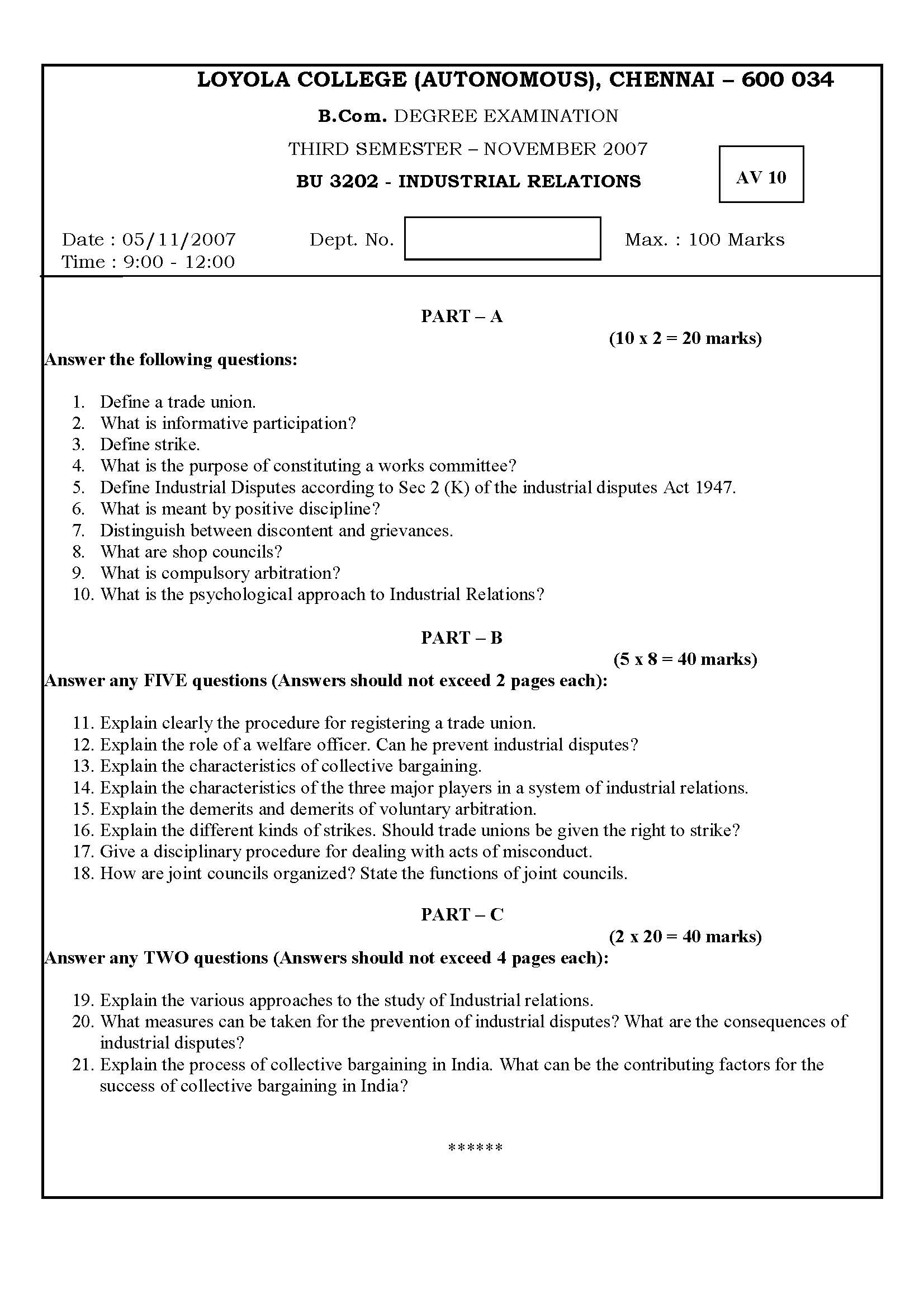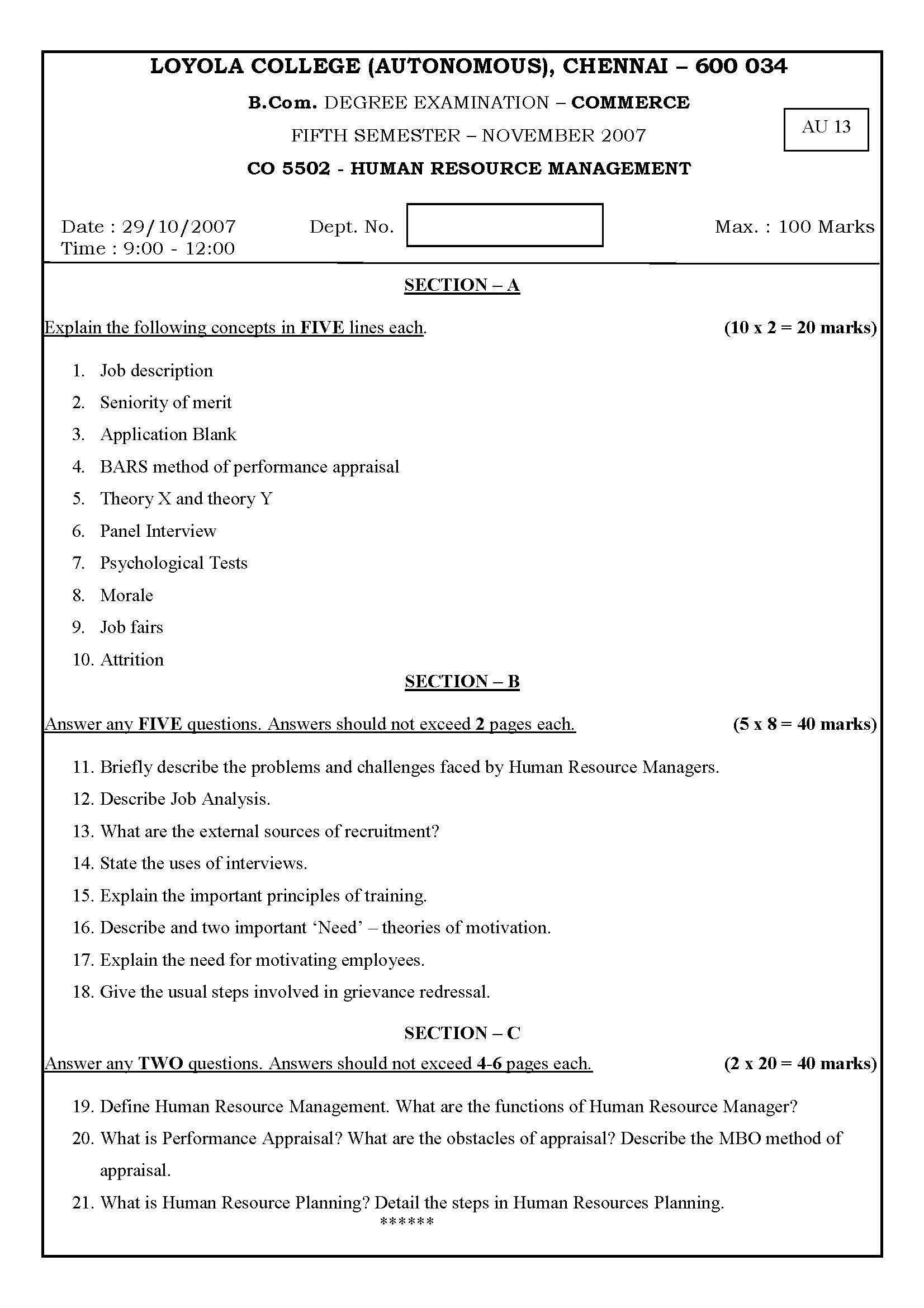LOYOLA COLLEGE (AUTONOMOUS), CHENNAI – 600 034 B.B.A DEGREE EXAMINATION – BUSINESS ADMINISTRATION
FIFTH SEMESTER – NOV 2006
BU 5501 – COST & MANAGEMENT ACCOUNTING
(Also equivalent to BUA 507)
Date & Time : 27-10-2006/9.00-12.00 Dept. No. Max. : 100 Marks
Section –A
( Answer all Questions) (10×2=20)
1.Define cost Accountancy.
2.Give four examples of indirect expenses.
3.What do understand by perpetual inventory system?
4.What do you mean by Normal idle time?
5.Calculate the value of cost of goods sold.
Rs
Net works cost 2,00,000
Office overhead 40,000
Selling overhead 30,000
Opening stock of finished goods 8,000
Closing stock of finished goods 10,000
6.Calculate average collection period from the following particulars
Rs
Credit sales for the year 12,000
Debtors 1,000
Bills receivable 1,000
7.What is meant by stock turnover ratio?.
8.Ascertain provision made for tax during 2005-06
Rs
Provision for tax on 1-4-2005 80,000
Provision for tax on 31-3-2006 1,00,000
Tax paid during the year 60,000
9.Define marginal costing.
10.Calculate p/v ratio from the particulars.
2004; Sales Rs.6,00,000 ; Profit Rs.1,00,000
2005; Sales Rs.10,00,000 ; Profit.Rs.1,80,000
SECTION-B
( Answer any five questions, choosing not less than TWO from each group)
(5×8=40)
GROUP-I
- Explain in detail the advantages and disadvantages of Cost accounting.
12.Apportion the overheads among the departments A,B,C an D.
Rs Rs
Works manager’s salary 4,000 Power 21,000
Contribution to P.F. 9,000 Depreciation 20,000
Plant maintenance 4,000 Rent 6,000
Canteen expenses 12,000
Additional information;
| Particulars |
A |
B |
C |
D |
| Number of employees
Area occupied
( sq.feet) Value of the plant
(Rs)
Wages (Rs)
Horse power |
16
2,000
75,000
40,000
3 |
8
3,000
1,00,000
20,000
3 |
4
500
25,000
10,000
1 |
4
500
—-
5,000
—-
|
- .The following information is pertaining to a Firm
Annual consumption – 12,000 units (360) days
Cost per unit – Re.1
Cost per order – Rs.12
Inventory carrying cost – 20%
Lead time (maximum, normal, minimum) 30-15-5 (days)
Daily consumption (maximum, normal, minimum) ,45-33-15 (units)
Calculate EOQ and Inventory levels.
14.a) From the following particulars , workout the total amount payable to the three
workmen and the rate earned by them under;
i)Halsey plan and b) Rowan plan .
Standard time allowed ; 12 hours
Actual time taken by;
A-8 hours, B-6 hours , C-4 hours. (4)
- b) A company presents the following information ;
Number of employees 0n 1-1-2005 ; 200
Number of employees as on 31-12-2005; 240
Number of employees resigned ; 20
Number of employees discharged ; 5
Number of employees replaced ; 18
Calculate labour turnover ratios under all the methods. (4)
GROUP-II
15 a) Compare and contrast between Management Accounting and Cost Accounting.(4)
- b) Write short notes on the following (4)
- i) BEP ii) Margin of safety
16.A company presents the following information,
| year |
units |
Total cost (Rs) |
Sales(Rs)
|
| 2004 |
10,000 |
80,000 |
1,00,000 |
| 2005 |
12,000 |
90,000 |
1,20,000 |
Find out the following;
- P/V ratio b) BEP both in units and amount c) Fixed cost d) margin of safety for the year 2005.
17.From the following data, calculate the following ratios.
a)Current ratio b) Liquid ratio c) Debt Equity ratio d) Fixed assets ratio.
Balance sheet as on 31-3-2004
——————————————————————————————————–
Liabilities Rs Assets Rs
Equity capital 1,00,000 Land & building 75,000
Reserve fund 50,000 Plant& machinery 80,000
Profit&loss a/c 20,000 Stock in trade 30,000
10% debentures 50,000 Sundry debtors 50,000
Sundry creditors 30,000 Bills receivable 20,000
Bills payable 15,000 Cash in hand 10,000
———– ————-
2,65,000 2,65,000
———— ————-
18.From the following profit& loss a/c , calculate the following ratios.
- A) G/P ratio b) N/P ratio c) Operating profit ratio d) Operating ratio
—————————————————————————————————
Particulars Rs Particulars Rs.
—————————————————————————————————-
To opening stock 1,00,000 By sales 5,60,000
To purchases 3,50,000 By closing stock 1,00,000
To wages 9,000
To Gross profit 2,01,000
———– ————
6,60,000 6,60,000
———– ————-
To Administrative exp 20,000 By Gross profit 2,01,000
To selling expenses 89,000 By interest on investments 10,000
To Non- operating exp 30,000 By profit on sale of investments 8,000
To Net profit 80,000
———— ————
2,19,000 2,19,000
————- ————-
SECTION-C
(Answer any two questions ) (2X20=40)
19.a) From the following transactions, prepare separately the stores ledger account,
using The following methods; a) FIFO b) LIFO
Jan 1. Opening balance 100 units @ Rs.5 each.
5 Received 500 units @ Rs.6 each.
7 Issued 300 units
9 Issued 200 units
10 Received back from work order 10 units issued on 9th February.
13.Received 600 units @ Rs.5 each.
16.Issued 300 units.
- Returned to supplier 50 units purchased on 13th January
- Issued 200 units.
- Received 500 units at Rs.7 per unit.
- Issued 300 units.
Stock verification on 27th January revealed a shortage of 10- units..
OR
19.b) I) Following data is obtained in the books of –V –Ltd for the year2005
Opening stock of raw materials 25,000
Closing stock of raw materials 40,000
Purchase of raw materials 85,000
Carriage inwards 5,000
Direct wages 75,000
Indirect wages 10,000
Other direct charges 15,000
Rent and rates –
Factory 5,000
Office 500
Indirect consumption of materials 500
Depreciation of plant 1,500
Depreciation of office furniture 100
Office salary 2,500
Salesmen salary 2,000
Other office expenses 900
Other factory expenses 5,700
Managing director’s remuneration 12,000
Other selling expenses 1,000 Travelling expenses 1,100
Carriage outwards 1,000
Sales 2,50,000
Advance income tax paid 15,000
Advertisement 2,000
Managing director’s remuneration is allocated as Rs.4,000 to the factory , Rs.2,000
To the office and Rs.6,000 to the selling departments.
Prepare a cost sheet showing the following;
- Prime cost b) Works cost c) cost of production d) cost of sales e) Net profit.
20 a).The following are the summarized Balance sheets of L- Ltd as on 31-st
Dec.2003 and 2004, you are required to prepare , a) Schedule of changes in the
working capital
- Fund flow statement.
Balance sheet
—————————————————————————————————-
Liabilities 30-6-2003 30-6-2004 Assets 30-6-2003 30-6-2004
(Rs) ( Rs) (Rs) ( Rs)
—————————————————————————————————-
Share capital 1,80,000 2,00,000 Goodwill 24,000 20,000
Reserve fund 28,000 36,000 Building 80,000 72,000
P&L A/c 39,000 24,000 Machinery 74,000 72,000
Trade creditors 16,000 10,800 Investments 20,000 22,000
Bank overdraft 12,400 2,600 Inventories 60,000 50,800
Prov. For tax. 32,000 34,000 Cash 13,200 30,400
Prov. For doubtful 3,800 4,200 Debtors 40,000 44,400
Debts
—————————- ————————–
3,11,200 3,11,600 3,11,200 3,11,600
—————————- —————————
Additional information;
- i) Depreciation charged on machinery Rs.10,000 and on buildings Rs.8,000
- ii) Investments sold during the year Rs.3,000
iii) Rs.15,000 interim dividend paid during Jan.2004
- iv) Taxes paid during the year Rs.30,000.
OR
20.b)Balance sheets of A and B are as follows, You are asked to prepare cash flow statement.
Balance sheets
——————————————————————————————————–
Liabilities 2003 2004 Assets 2003 2004
Rs Rs Rs Rs
Equity share capital 3,00,000 4,00,000 Goodwill 1,15,000 90,000
Land& building 2,00,000 1,70,000
8% Red.pre.cap. 1,50,000 1,00,000 Plant 80,000 2,00,000
General reserve 40,000 70,000 Debtors 1,60,000 2,00,000
P&L A/C 30,000 48,000 Stock 77,000 1,09,000
Proposed dividend 42,000 50,000 Bills receivable 20,000 30,000
Creditors 55,000 83,000 Cash in hand 15,000 10,000
Bills payable 20,000 16,000 Cash at bank 10,000 8,000
Provision for taxation 40,000 50,000
————————— ———————–
6,77,000 8,17,000 6,77,000 8,17,000
————————— ————————
Additional information;
- Depreciation of Rs.10,000 and 20,000 have been charged on plant account and
Land and building account respectively in2004
- An interim dividend of Rs.20,000 has been paid in 2004.
- Income tax of Rs.35,000 was paid during the year 2004.
Go To Main page




